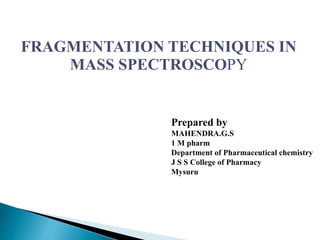
Mass Spectroscopy Fragmentation Techniques
- 1. FRAGMENTATION TECHNIQUES IN MASS SPECTROSCOPY Prepared by MAHENDRA.G.S 1 M pharm Department of Pharmaceutical chemistry J S S College of Pharmacy Mysuru
- 2. Definition: It is a powerful analytical technique useful for determination of molecular weight of compound. Principle: Initially in mass spectroscopy the sample must be converted into vapourised or gaseous form then it undergo ionization to form a molecular ion with the liberation of 1e-. This molecular ion normally undergoes fragmentation to form several fragmented ions or daughter ions.
- 3. The process of breaking up of molecular ion into smaller or daughter ions is known as “fragmentation”. The molecular ion commonly decomposes to a pair of fragments, which may be either a radical with an ion or a small molecule & a radical cation.
- 4. Bombardment of molecules by a electron beam with energy between 10-15ev usually results in the ionization of molecules by removal of one electron (molecular ion formation). When the energy of electron beam is increased between 50-7ev, these molecular ions acquire a high excitation resulting in their break down into various fragments.
- 5. Fragmentation of the molecular ion takes place in following mods: Simple cleavage 1. Homolytic cleavage 2. Heterolytic cleavage 3. Semi heterolytic cleavage Rearrangement reactions 1. Elimination reactions 2. Ortho reaction 3. Mc-lafferty rearrangement
- 6. In hemolytic cleavage the electrons are equally transferred to both atoms & it forms radical and cation. R H2C CH CH2 R H2C CH CH2 R + CH HC CH2 IONISATION HOMOLYTIC CLEAVAGE
- 7. Fragmentation by movement of two electrons: In this type of cleavage both the electrons of the bond are taken over by one of the atoms; the fragments are an even electron cation and a radical with the positive charge residing on the alkyl group.C4H9I ionisation CH3 CH2 + I C4H9I HETEROLYTIC CLEAVAGE
- 8. In this one electron bond cleavage takes place resulting in formation of radical & cation. C H H H H C H H H H CH3 + H IONISATION CLEAVAGE
- 9. It involves the cleavage of bonds and formation of new bonds i.e., it requires changes to at least two bonds. So the produced ions are not structural units of precursors. Generally rearrangement leads to loss of smaller molecules.
- 10. In his fragmentation hydrogen is obstructed by hydroxyl group or halogen or acetate functional groups results in the elimination of water or neutral molecule. R – CH2 – CH2 –CH2 R – CH2 – CH2 – CH2 + OCOCH3 OCOCH3 CH3COOH + R – CH2 – CH = CH2
- 11. In the case of substituted aromatic compounds the substitute & carbon come into proximity has help in elimination of neutral molecule. This effect is called ortho effect. O O CH3 CH3 O O CH3 C H2 C O CH2 + OCH3 H C C C O CH2 + CH3OH methyl 2-methylbenzoate methyl 2-methylbenzoate ion (6-methylenecyclohexa-2,4- dienylidene)methanone H
- 12. The loss of an alkene fragment by cyclic rearrangement of a carbonyl compounds ( like aldehyde, ketones, acids, esters, amines), unsaturated compounds with γ-hydrogens undergo Mc-Lafferty rearrangement. Or It involves the migration of γ-hydrogen atom followed by cleavage of β-bond then rearrangement leads to the elimination of neutral molecule.
- 13. Fragmentation takes place only at γ-hydrogen Then this hydrogen is obstructed by oxygen of carbonyl group or unsaturated compound. Carbonyl group is converted to hydroxyl group Bond break down between α & β carbons resulting in liberation of 2e-’s then rearrangement takes place to form a simple alkene.
- 14. H H2C C H2 CH2 C HO butyraldehyde H H2C C H2 CH2 C HO H2C C H CH C HHO CH2 CH2 + OH C CH2 H O C CH3 H H H2C C H2 CH2 C HO IONISATION EXAMPLE: Aldehyde If m/z value is 44(24+4+16) that indicates aldehyde is present and connected to C3 chain.
- 15. H H2C C H2 CH2 C CH3O H H2C C H2 CH2 C CH3O H2C C H CH2 CH CH3HO CH2 CH2 + CH2 C CH3HO CH3 C CH3O H H2C C H2 CH2 C CH3 O pentan-2-one ionisation If m/z value is 58 (36+16+6) that indicates the compound containing ketone group attached to C3 chain Ex:- ketone
- 16. H H2C C H2 CH2 C NH2O H H2C C H2 CH2 C NH2O H2C C H CH2 CH NH2HO CH2 CH2 + CH2 C NH2HO CH3 C NH2O butyramide H H2C C H2 CH2 C NH2O ionisation Ex:-Amides If m/z value is 59 (24+16+14+5) that indicates the compound containing amide group attached to C3chain
- 17. REFERENCES: Instrumental methods of chemical analysis- B.K Sharma, Instrumental methods of analysis By Chatwal, Principles of Instrumental analysis By Donglas Skoog